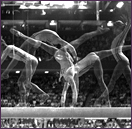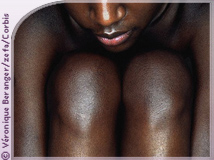
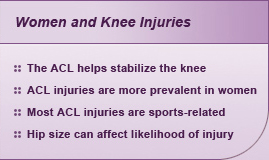
You’ve gotten off the couch and dusted off your cross-trainers; the women in the neighborhood have convinced you to sign up for the local marathon and you’re feeling more energetic and fit than ever before. Then, it happens: A knee injury brings your active lifestyle to a grinding halt.
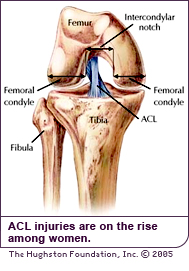 Knee injuries in women, specifically injuries to the ACL (that’s anterior cruciate ligament, a tiny ligament that attaches on the upper leg bone [femur] and passes through a “tunnel” before attaching on the lower bone [tibia]), have become more prevalent than ever. The ACL is most commonly injured during activities like planting and cutting (where an athlete runs and stops quickly, with or without pivoting) and straight-knee landing, all moves that are frequent in such sports as gymnastics, basketball and soccer. This ligament plays an important role in stabilizing the knee, preventing the lower leg from moving too far forward (anterior translation) in relation to the thighbone. An ACL tear can be devastating to an athlete’s season. Typical treatments can include, at best, ice, anti-inflammatory medications and physical therapy. But serious ACL injuries require surgical reconstruction of the ligament using screws, followed by significant rehabilitation, and the recovery time takes about six months.
Knee injuries in women, specifically injuries to the ACL (that’s anterior cruciate ligament, a tiny ligament that attaches on the upper leg bone [femur] and passes through a “tunnel” before attaching on the lower bone [tibia]), have become more prevalent than ever. The ACL is most commonly injured during activities like planting and cutting (where an athlete runs and stops quickly, with or without pivoting) and straight-knee landing, all moves that are frequent in such sports as gymnastics, basketball and soccer. This ligament plays an important role in stabilizing the knee, preventing the lower leg from moving too far forward (anterior translation) in relation to the thighbone. An ACL tear can be devastating to an athlete’s season. Typical treatments can include, at best, ice, anti-inflammatory medications and physical therapy. But serious ACL injuries require surgical reconstruction of the ligament using screws, followed by significant rehabilitation, and the recovery time takes about six months.
One logical reason why more women are suffering from knee injuries might just be that more women are active than ever before. But interestingly, female athletes are more likely than male athletes to injure the ACL. Are women actually more prone to knee injuries than men?
Pushing the Limits
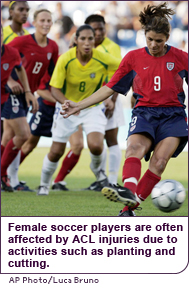 Changes in society have created a higher standard of competition for female athletes, and women are playing harder than ever. “The number of girls and women participating in all levels of sports has risen greatly in recent years, and the way they play has changed too,” according to the 1997 article “Anterior Cruciate Ligament Injuries in Female Athletes: Why Are More Women Susceptible?” by James L. Moeller, MD, and Mary M. Lamb, MD, published in The Physician and Sportsmedicine Journal. “Women’s sports, once dominated by a slow, defensive style, are now played with speed, precision and power.”
Changes in society have created a higher standard of competition for female athletes, and women are playing harder than ever. “The number of girls and women participating in all levels of sports has risen greatly in recent years, and the way they play has changed too,” according to the 1997 article “Anterior Cruciate Ligament Injuries in Female Athletes: Why Are More Women Susceptible?” by James L. Moeller, MD, and Mary M. Lamb, MD, published in The Physician and Sportsmedicine Journal. “Women’s sports, once dominated by a slow, defensive style, are now played with speed, precision and power.”
This trend makes it easier to understand why top athletes would receive ACL injuries, but even your average fitness buff isn’t immune to physical wear and tear in the knee area. “We are seeing increases in the occurrence of ACL injuries not only with elite athletes but also the recreational or weekend athlete,” says Jennifer Dougherty, owner of The Athletic Advantage, Sports Medicine and Massage Therapy in Golden, Colorado.
While the fact that more women are playing sports and exercising harder than ever before accounts for the rise of knee injuries, it doesn’t explain why ACL injuries are so much more prevalent than injuries involving other structures in the knee. To understand why is to enter a debate that has gender differences at its core.
The Q Factor
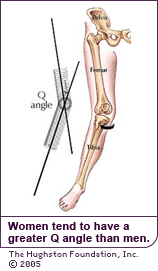 Experts believe a combination of risk factors makes female athletes more likely to injure the ACL than male athletes. The majority of research done in this area focuses on genetic differences between males and females, such as structural and hormonal differences. Among these is the Q angle, which is the angle at which the bones that make up the knee come together and form the bulk of the knee joint in relation to the kneecap. The Q angle is primarily determined by the width of a woman’s hips, which in turn determines the angle of the knee joint. Women naturally have wider hips than men and consequently have a greater Q angle. This places the ACL at greater risk of injury when exposed to the excessive forces seen in physical activities.
Experts believe a combination of risk factors makes female athletes more likely to injure the ACL than male athletes. The majority of research done in this area focuses on genetic differences between males and females, such as structural and hormonal differences. Among these is the Q angle, which is the angle at which the bones that make up the knee come together and form the bulk of the knee joint in relation to the kneecap. The Q angle is primarily determined by the width of a woman’s hips, which in turn determines the angle of the knee joint. Women naturally have wider hips than men and consequently have a greater Q angle. This places the ACL at greater risk of injury when exposed to the excessive forces seen in physical activities.
In addition to a larger Q angle, females have been shown to have a narrower intercondylar notch, the tunnel through which the ACL passes before attaching to the bones of the upper and lower leg. This presents an increased risk of injury in activities that require highly agile moves such as quick changes in direction and pivoting or twisting actions.
Other areas researchers are studying include the hormonal differences between males and females. Ligaments are affected by hormones, and certain hormones prevalent in women, such as estrogen and relaxin, tend to cause ligaments to relax. These hormones act on the fibers of the ligament, causing them to stretch and be more pliable. As ligaments become more relaxed, they become more susceptible to injury. Studies are still being done in this area, but these hormonal differences may account for much of the gender discrepancy in ACL injury rates.
Although these hormonal factors receive more attention in studies on females’ ACL injuries, factors that originate outside the knee may play just as important a role. For example, women land from jumps with their legs and hips in a different position than men use, and this may place the ACL under greater strain. Also, men tend to bend their knees more when they land; women often land with their hips and legs straight, putting unnecessary extra pressure on the knee joints.
Also, women tend to have less muscle mass and more strength imbalances than men. This results in less strength in the muscles surrounding the knee, and less stabilization of the knee joint by these surrounding muscles.
Most experts agree that the increase in female ACL injuries is caused by an intricate combination of all these factors. But don’t let the stats scare you. Women’s lifestyles are more active and healthier than ever before, and the benefits of working out far outweigh the detriments. Get educated about your favorite sport by hiring a trainer, asking your gym staff or reading a book. Learn the right way to exercise in order to keep injuries at a minimum. Keep exercising, implement a strengthening program designed to prevent knee injuries, stay healthy and, most of all, have fun.
:: Gwyneth Short
Read More About Knee Injuries





